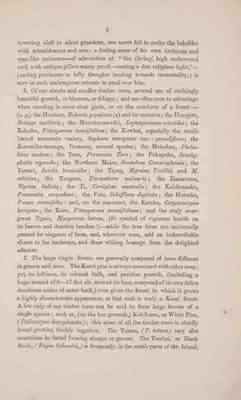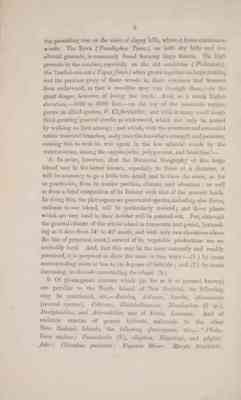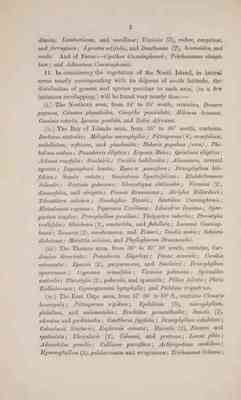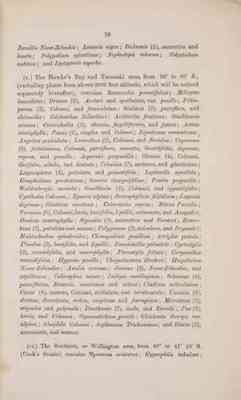Pages
5 towering aloft in silent grandeur, can never fail to strike the beholder with astonishmment and awe: a feeling sense of his own littleness and span-like existence - of admiration at "the (living) high embowered roof, with antique pillars massy proof, - casting a dim religious light," - (ending perchance in lofty thoughts tending towards immortality,) is sure in such umbrageous retreats to steal over him.
6. Of our shrubs and smaller timber trees, several are of strikingly beautiful growth, or blossom, or foliage; and are often seen to advantage when standing in some clear glade, or on the outskirts of a forest:- (e.g.) the Houhere, Hoheria populnae (a) and its varieties; the Horopito, Drimys axillaris; the Manuka-rau-riki, Leptospermum ericoides; the Kohuhu, Pittosporum tenuifolium; the Kowhai, especially the smallleaved mountain variety, Sophora tetraptera var.: grandiflora; the Koromiko-taranga, Veronica, several species; the Mairehau, Phebalium nudum; the Toro, Persoonia Toro; the Pukapuka, Brachyglottis repanda; the Northern Maire, Santalum Cunninghamii; the Tawari, Ixerba brexioides; the Tipau, Myrsine Urvillei and M. salicina; the Tangeao, Tetranthera calicaris; the Ramarama, Myrtus bullata; the Ti, Cordyline australis; the Kahikomako, Pennantia corymbosa; the Pate, Schefflera digitata; the Horoeka, Panax crassifolia: and, on the sea-coast, the Karaka, Corynocarpus laevigata; the Karo, Pittosporum crassifolium; and the truly evergreen Ngaio, Myoporum laetum, (fit symbol of vigorous health on its barren and desolate beaches!) - while the tree ferns are universally praised for elegance of form and, wherever seen, add an indescribable charm to the landscape, and draw willing homage from the delighted admirer.
7. The large virgin forests are generally composed of trees different in genera and sizes. The Kauri pine is always associated with other trees; yet, its loftiness, its colossal bulk, and peculiar growth, (including a huge mound of 8-12 feet alt. around its base, composed of its own fallen deciduous scales of outer bark,) ever gives the forest in which it grows a highly characteristic appearance, so that such is truly a Kauri forest. A few only of our timber trees can be said to form large forests of a single species; such as, (on the low grounds,) Kahikatea, or White Pine, (Podocarpus dacrydioides); this alone of all the timber trees is chiefly found growing thickly together. The Totara, (P. totara) may also sometimes be found forming clumps or groves. Te Tawhai, or Black Birch, (Fagus Solandri,) is frequently, in the south parts of the Island,
6 the prevailing tree on the sides of clayey hills, where it forms continuous woods. The Tawa (Nesodaphne Tawa), on both dry hills and low alluvial grounds, is commonly found forming large forests. On high grounds in the interior, especially on the old sandstone (Palaeozoic), the Tawhai-rau-nui (Fagus fusca) often grows together in large forests; and the peculiar glory of these woods is, their openness and freeness from underwood, so that a traveller may run through them - to the great danger, however, of losing the track. And, at a much higher elevation, - 4000 to 6000 feet, - on the top of the mountain ranges, grows an allied species, F. Cliffortioides; and with it many small tough thick-growing gnarled shrubs as underwood, which can only be passed by walking on (not among); and which, with the prostrate and concealed rotten trees and branches, sadly tires the traveller's strength and patience, causing him to wish he was again in the low alluvial woods by the water-courses, among the supple-jacks, polygonums and brambles! -
8. In order, however, that the Botanical Geography of this large island, may be the better known, especially to those at a distance, it will be necessary to go a little into detail, and to show the same, as far as practicable, from its insular position, climate, and situation; as well as from a brief comparison of its Botany with that of the nearest lands. In doing this the phaenogamous genera and species, including also Ferns, endemic to our island, will be particularly noticed; and those plants which are very local in their habitat will be pointed out. For, although the general climate of the whole island is temperate and genial, (extending as it does from 34° to 42° south, and with only two elevations above the line of perpetual snow,) several of its vegetable productions are remarkably local. And, that this may be the more naturally and readily perceived, it is purposed to show the same in two ways:- (1.) by area corresponding more or less to its degrees of latitude; and (2.) by zones increasing in altitude surrounding the island. (b)
9. Of phaenogamic GENERA which (as far as is at present known) are peculiar to the North Island of New Zealand, the following may be mentioned, viz., - Entelea, Ackama, Ixerba, Alseuosmia (several species), Colensoa, Rhabdothamnus, Nesodaphne (2 sp.), Dactylanthus, and Adenochilus; and of Ferns, Loxsoma. And of endemic SPECIES of genera hitherto unknown to the other New Zealand Islands, the following phaenogams, viz., - *Phebalium nudum; Pomaderris (3.), elliptica, Edgerleyi, and phylicifolia; Clianhus puniceus; Eugenia Maire; Meryta Sinclairii;
8 *Sapota costata; Olea (3), Cunninghamii, lanceolata, and montana; Geniostoma ligustrifolium; Calceolaria (2), Sinclairii, and repens; Glossostigma elatinoides; Vitex littoralis; *Pisonia Brunoniana; Tetranthera calicaris; Knightia excelsa; Persoonia Toro; Santalum Cunningamii; Elatostemma rugosum; Dammara australis; Sarcochilus adversus; Alepyrum pallidum; Ehrharta Colensoi; Microloena (2), avenacea, and polynoda; Catabrosa antarctica: and of Ferns:- Doodia (2), media and caudata; Arthropteris tenella; Nephrolepis tuberosa; Lygodium articulatum; and Phylloglossum Drummondii.*
10. Besides which there are very many species peculiar to the North Island, but of genera common to all New Zealand; of which species the more notable are the following, viz.,- of phaenogams:- Ranunculus (2), insignis, and nivicola; Melicytus (2), macrophyllus, and lanceolatus; Pittosporum (6), cornifolium, crassifolium, umbellatum, Colensoi, pimeleoides and reflexum; Hokeria (2.) popunea, (vera) and Sinclairii; Aristotelia Colensoi; Carmichaelia pilosa; Quintinia elliptica; Metrosideros (5) albiflora, diffusa, Colensoi, Robusa and tomentosa; Myrtus (2) bullata and Ralphii; Tetragonia trigyna; Panax Sinclairii; Corokia buddleoides; Loranhus tenuiflorus; Coprosma (9), spathulata, tenuicaulis, grandifolia, petiolata, propinqua, Colensoi, depressa, repens, and microcarpa; Nertera (2), Cunninghamii,, and setulosa; Olearia (4), furfuracea, Forsteri, albida, and Solandri; Lagenophora lanata; Cassinia retorta; Brachycome odorata; Senecio (5), latifolius, Colensoi, Greyii, perdicioides, glastifolius, and eloeagnifolius; Forstera Bidwillii; Pratia perpusilla; Gaultheria (3), Colensoi, fagifolia, and oppositifolia; Epacris Sinclairii; Dracophyllum (4). latifolium, squarrosum, subulatum, and recurvum; Myrsine (3), salicina, montana, and divaricata; Logania depressa; Exarrhena petiolata; Vernoica (5,) pubescens, diosmaefolia, nivalis, spathulata, and elongata; Utricularia (3), Novae Zelandiae, Colensoi and protrusa; Plantago uniflora,; Chenopodium pusillum; Pimelea (3), buxifolia, arenaria, and prostrata; Libocedrus Doniana; Phyllocladus trichomanoides; Acianthus Sinclairii; Prasophyllum (3), unicatum, pumilum, and nudum; Thelymitra (2), Colensoi, and imberlis; Pterostylis (4), micromega, foliata, trullifolia, and puberula; Cordyline Pumilio; Astelia (2), linearis, and Banksii; Arthropodium cirrhatum; Juncus capillaceus; Luzula Colensoi; Chaetospora (4) Tendo, Brownii, concinnus, and nitens; Gahnia xanthocarpa; Carex (4), acicularis, *Those prefixed thus * are also found at Norfolk Island. B
9 dissita, Lambertiana, and vacillans; Uncinia (3), rubra, caespitosa, and ferruginea; Agrostis setifolia, and Danthonia (2), bromoides, and nuda. And of Ferns:- Cyathea Cunninghamii; Trichomanes elongatum; and Adiantum Cunninghamii.
11. In considering the vegetation of the North Island, in lateral areas nearly corresponding with its degrees of south latitude, the distribution of genera and species peculiar to each area, (in a few instances overlapping,) will be found very nearly thus:-
(i) The Northern area, from 34o to 35o south, contains, Drosera pygmaea, Colensoa physaloides, Cassytha paniculata, Hibiscus trionum, Cassinia retorta, Ipomaea pendula, and Todea Africana.
(ii) The Bay of Islands area, from 35o to 36o south, contains, Barbarea australis; Melicytus macrophyllus; Pittosporum (4), cornifolium, umbellatum, reflexum, and pimeleoides; Hoheria populnea (vera); Phebalium nudum; Pomaderris elliptica; Eugenia Maire; Quintinia elliptica; Ackama rosaefolia; Sinclairii; Corokia buddleoides; Alseuosmia, several species; Lagenophora lanata; Epacris pauciflora; Dracophyllum latifolium; Sapota costata; Geniostoma ligustrifolium; Rhabdothamnus Solandri; Gratiola pubescens; Glossostigma elatinoides; Veronica (2), diosmoefolia, and elongata; Pisonia Brunoniana; Atriplex Billardieri; Tetranthera calicaris; Nesodaphne Tarairi; Santalum Cunninghamii; Elatostemma rugosum; Peperomia Urvilleana; Libocedrus Doniana; Sparganium simplex; Prasophyllum pumilum; Thelymitra imberbis; Pterostylis trullifolia; Gleichenia (2), semivestita, and flabellata; Loxsoma Cunninghamii; Lomaria (2), membranacea, and Fraseri; Doodia media; Schizaea dichotoma; Marattia salicina, and Phylloglossum Drummondii.
(iii) The Thames area from 30o to 37o 30' south, contains, Cardamine divaricata; Pomaderris Edgerleyi; Panax anomala; Corokia cotoneaster; Epicris (2), purpurascens, and Sinclairii; Dracophyllum squarrosum; Coprosma crassifolia; Veronica pubescens; Spiranthes australis; Pterostylis (2), puberula, and squamata; Pellaea falcaa; Pteris Endlicheriana; Gymnogramma leptophylla; and Psilotum triquetrum.
(iv.) The East Cape area, from 37o30' to 39o S., contains Clematis hexasepala; Pittosporum rigidum; Epilobium (3), microphyllum, glabellum, and melanocaulon; Erechtites prenanthoides; Senecio (2), odoratus and perdicioides; Gaultheria fagifolia; Dracophyllum subulatum; Calceolaria Sinclarii; Euphrasia cuneaa; Myostis (2), Forsteri and spathulata; Utricularia (2), Colensoi, and protrusa; Lemna gibba; Adenochilus gracilis; Callixene parviflora; Arthropodium candidum; Hymenophyllum (2), pulcherrimum and aeruginosum; Trichomanes Colensoi;
10 Davallia Novae-Zelandiae; Lomaria nigra; Dicksonia (2), antarctica and lanata; Polypodium sylvaticum; Nephrolepis tuberosa; Polystichum vetitum; and Leptopteris superba.
(v) The Hawke's Bay and Taranaki area, from 39o to 40o S., (excluding plants from above 4000 feet altitude, which will be noticed separately hereafter), contains Ranunculus geraniifolius; Melicytus lanceolatus; Drosera (2) Arcturi and spathulata, var. pusilla; Pittosporum (2), Colensoi, and fasciculatum: Stellaria (2), parviflora, and elatinoides; Colobanthus Billardieri; Aristotelia fructicosa; Stackhousia minima; Carmichaelia (3), odorata, flagelliformis, and juncea; Acoena microphylla; Panax (2), simplex and Colensoi; Ligusticum aromaticum; Angelica geniculata; Loranthus (2), Colensoi and flavidus; Coprosma (8), Foetidissima, Colensoi, parviflora, cuneata, linariifolia, depressa, repens, and pumila; Asperula perpusilla; Olearia (4), Colensoi, ilicifolia, nitida, and dentata; Celmisia (2), coriacea, and glandulosa; Lagenophora (2), petiolata, and pinnatifida; Leptinella squalida; Gnaphalium prostratum; Senecio elaeagnifolius; Pratia perpusilla Wahlenbergia saxicola; Gaultheria (2), Colensoi, and oppositifolia; Cyathodes Colensoi; Epacris alpina; Dracophyllum filifolium; Logania depressa; Gentiana montana; Calceolaria repens; Mazus Pumilio; Veronica (6), Colensoi, laevis, buxifolia, Lyallii, cataractae, and Anagallis; Ourisia macrophylla; Myosotis (2), antarctica and Foresteri; Exarrhena (2), petiolata and saxosa; Polygonum (2), aviculare, and Dryandri; Muhlenbeckia ephedroides; Chenopodium pusillum; Atriplex patula; Pimelea (2), buxifolia, and Lyallii; Zanichellia palustris; Cyrtostylis (2), rotundifolia, and macrophylla; Pterostylis foliata; Corysanthes rotundifolia; Hypoxis pusilla; Chrysobactron Hookeri; Herpolirion Novae-Zelandiae; Astelia nervoisa; Juncus (2), Novae-Zelandiae, and capillaceus; Calorophus minor; Isolepis cartilaginea; Schoenus (4), pauciflorus, Brownii, concinnus and nitens; Cladium articulatum; Carex (4), inversa Colensoi, stellulata and teretiuscula; Uncinia (5), distans, divaricata, rubra, caespitosa and ferruginea; Microloena (2) stipoides and polynoda; Danthonia (2), nuda, and Raoulii; Poa (2), laevis, and Colensoi; Gymnostichum gracile; Gleichenia dicarpa var. alpina; Alsophila Colensoi; Asplenium Trichomanes; and Riccia (2), acuminata, and natans.
(vi.) The Southern, or Wellington area, from 40o to 41o 40' S. (Cook's Straites) contains Myosurus aristatus; Gypsophila tubolosa;




